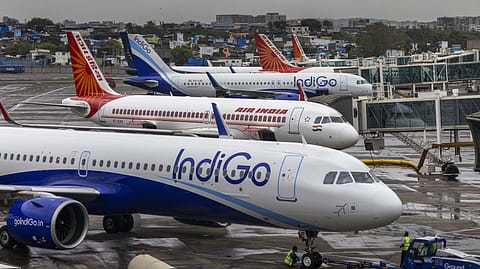Aviation’s next leap: India eyes global hub status amid innovation push
At the International Conference on Air Mobility, industry leaders and policymakers explore how innovation and sustainability can cement India’s place as a global aviation hub

With an unprecedented surge in demand for air travel, the country is witnessing a convergence of opportunities and challenges across its aviation ecosystem—encompassing airlines, airports, MRO services, manufacturing, and emerging technologies like urban air mobility. At the International Conference on Air Mobility, industry leaders and policymakers came together to chart a course for the future, exploring how innovation and sustainability can redefine the sector and cement India’s place as a global aviation hub.
“The aviation sector today is no longer just about connecting cities; it’s about creating an interconnected ecosystem that meets the needs of passengers, businesses, and the environment,” said Amber Dubey, senior advisor at McKinsey & Company, who moderated the panel. With air passenger traffic set to triple by 2030, speakers emphasised the urgency of coordinated efforts to ensure this growth is inclusive, sustainable, and economically impactful.
A Sector Taking Flight
India’s aviation sector is undergoing a period of extraordinary growth. Christoph Schnellmann, CEO of Noida International Airport, described it as a “historic moment” for the industry. “Any capacity we bring to the market—be it in terms of airports, aircraft, or aviation professionals—is immediately absorbed. The demand is unprecedented, and we feel privileged to contribute to meeting this need.”
The growth is evidenced by major developments in infrastructure, with two international airports set to open soon. Schnellmann noted that these expansions are vital but warned that the focus must also remain on sustainability. “The challenge is not just creating capacity but ensuring it aligns with decarbonisation goals and meets our commitments to a sustainable future,” he added.
Despite this progress, India’s aviation ecosystem still faces significant hurdles, particularly in the Maintenance, Repair, and Overhaul (MRO) segment. “Currently, only 15% of MRO activities take place within India, with the rest outsourced overseas,” shared Sharad Agarwal, CEO of AI Engineering Services Ltd. He stressed the importance of bringing high-value work, such as engine overhauls, back into the country to reduce costs and enhance self-reliance. “Can an airport come up without having any bankers or any amount of investment and will an airline be comfortable operating at such an airport,” he asked.
Innovation in Mobility
Recommended Stories
A key highlight of the discussion was the potential for advanced air mobility solutions to reshape transportation. Marc Ausman, chief product officer at Electra, shared insights into hybrid-electric aircraft that promise to revolutionise short-haul travel. “Our aircraft are designed to operate cost-effectively and with reduced noise, enabling connectivity in regions with limited infrastructure,” he said. “Imagine small towns, villages, or even remote areas like the Himalayas or North East becoming accessible with minimal infrastructure investment.”
These innovations are not just about technology but also affordability. “We’re working to bring down costs significantly, making air mobility accessible to more than just the ultra-wealthy,” said Jonathan Sumner, chief strategy officer at JetSetGo Aviation Services. He likened this potential democratisation to the leapfrogging effect of mobile phones in developing economies. “Personal air mobility has the potential to become one of the biggest growth drivers in India’s economy, but only if we can make it affordable and widely available,” he added.
The integration of urban air mobility with existing transportation networks was another key theme. Schnellmann explained how Noida International Airport is being designed as more than just a transit hub. “We envision it as a node in a broader connectivity network, seamlessly integrating urban and regional mobility,” he said.
Sustainability Imperative
(INR CR)
While the promise of growth is exhilarating, the industry faces the twin challenges of sustainability and technological adaptation. “We are at the beginning of an electric future in aviation,” said Ausman. He emphasised the long-term potential of hybrid and electric aircraft in reducing emissions. The other aspect is cost. “Digital technology tends to get cheaper and cheaper over time. Batteries for the long-range mission will be ready in 30 years or so. And new motors and generators and components like that will inevitably get better as well because we're at the very beginning of these technologies,” he added.
Data and technology were also spotlighted as game-changers. Raj Tanwar, CHRO at AlonOS, stressed the role of artificial intelligence and data analytics in optimising operations. “Data is the new oil. By leveraging it effectively, we can create connected airports, enhance customer experiences, and address inefficiencies,” he said. However, he acknowledged that legacy systems and fragmented processes remain significant barriers.
The panellists agreed that addressing these challenges would require close collaboration between government and private players. Policies to encourage domestic MRO investments, support advanced mobility solutions, and incentivise sustainable practices are essential to the sector’s success.
The aviation sector is a microcosm of India’s broader economic aspirations and as the aviation industry evolves, bridging gaps in connectivity should align with a growth that is broad-based and benefits all sections of society.
“The opportunity we now have as an industry is to re-diversify, integrate last-mile connectivity, and integrate on-demand services,” said Sumner, while adding “If the private sector in the aviation – the big airlines – see that opportunity, as we're seeing across the globe, and extend that into the urban environment for very short-haul connectivity, then those players can reap big value.”